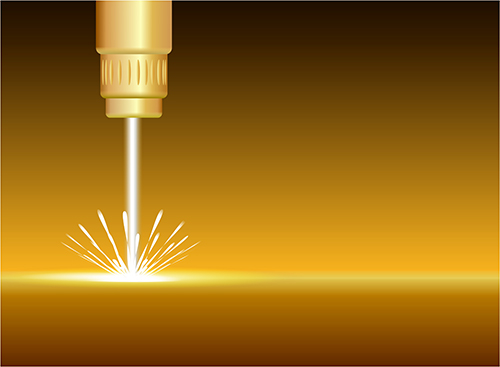![Researchers were able to combine a tumor-specific antibody with gold nanoparticles, “blasting” them with near-infrared light, frying the tagged cancerous tissue. [Schlegelfoto/Getty Images]](https://genengnews.com/wp-content/uploads/2018/08/Aug31_2017_Getty_517077295_AbstractGoldLaserIndustry_5003872131331-1.jpg)
Researchers were able to combine a tumor-specific antibody with gold nanoparticles, “blasting” them with near-infrared light, frying the tagged cancerous tissue. [Schlegelfoto/Getty Images]
“Hokey religions and ancient weapons are no match for a good blaster at your side, kid,” Han Solo famously uttered in the original Star Wars movie. Assuredly, his sentiment wasn’t in reference to treating cancer; however, with newly published data from investigators at the University of Colorado (CU) Cancer Center, the quote may have just become more apropos. The CU researchers were able to combine a tumor-specific antibody with gold nanoparticles, “blasting” them with plasmon resonance in near-infrared (NIR) light, frying the tagged tissue. Findings from the new study were published recently in Bladder Cancer in an article entitled “The Antineoplastic Activity of Photothermal Ablative Therapy with Targeted Gold Nanorods in an Orthotopic Urinary Bladder Cancer Model.”
In the current study, the CU researchers conjugated gold nanoparticles to an antibody that binds to epidermal growth factor receptor (EGFR) on the surface of bladder tumors. Gold nanoparticles have been used previously in this manner, but the CU scientists used some innovative conjugation therapy to create the modified antibody for this study. The nanoparticles can be treated with NIR light and heated preferentially, allowing for thermal ablation of targeted cells—within mice for the current analysis.
“How could we bring the nanorods to a tumor?,” asked senior study investigator Thomas Flaig, M.D., associate dean for clinical research at the CU School of Medicine and chief clinical research officer of UCHealth, at the onset of this research study. “The answer was EGFR. What cancer site would allow us to deliver infrared light? Oh, the bladder! And how would we deliver it? Well, in bladder cancer there are already lights on the scopes used in clinical practice that could do the job.”
“Gold nanorods linked to an anti-EGFR antibody (Conjugated gold NanoRods – CNR) were instilled into the bladder cavity of an orthotopic murine xenograft model with T24 bladder cancer cells expressing luciferase,” the authors wrote. “NIR light was externally administered via an 808 nm diode laser. This treatment was repeated weekly for 4 weeks. The anti-cancer effect was monitored by an in vivo imaging system in a non-invasive manner, which was the primary outcome of our study.”
Since the mouse bladder tumors were very small, the investigators incorporated the use of bioluminescence to measure the new methods efficiency at destroying the cancerous tissue. Tumors were grown using cells that express the enzyme luciferase—making them glow. The more a mouse bladder glowed, the more cancer was present. And conversely, the less it glowed, the more cancer had been killed by hot nanoparticles.
“The optimal approach for an individual treatment was 2.1 W/cm2 laser power for 30 seconds,” the authors penned. “Using this in vivo model, NIR light combined with CNR demonstrated a statistically significant reduction in tumor-associated bioluminescent activity (n = 16) compared to mice treated with laser alone (n = 14) at the end of the study (p = 0.035). Furthermore, the CNR+NIR light treatment significantly abrogated bioluminescence signals over a 6-week observation period, compared to pre-treatment levels (p = 0.045).”
Researchers compared mice injected with EGFR-directed nanoparticles and laser light to mice only treated with laser light and found that, indeed, tumors in mice with targeted gold nanoparticles glowed less than their counterparts in the control group. In fact, these tumors glowed less than they had before treatment, implying that the technique had successfully slowed and even reversed tumor growth. Side effects were minimal.
“We are highly encouraged by these results,” Dr. Flaig concluded. It's been an interesting problem-solving experience pursuing this technique from a futuristic idea to something that now shows real promise in animal models.”






